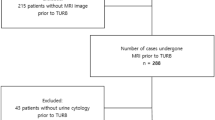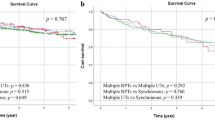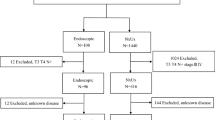Key Points
-
High-evidence-level recommendations for diagnosis, treatment and follow-up monitoring of patients with upper tract urothelial carcinomas (UTUCs) are lacking, but radical nephroureterectomy should no longer be considered the gold-standard treatment in all patients
-
Tumour grade and pathological stage are the main predictors of treatment outcome and the diagnostic challenge is selecting those patients with low-grade and low-stage tumours eligible for kidney-sparing therapy
-
Preoperative tumour staging is difficult with currently available imaging modalities but clinical variables have been identified to enable risk stratification and distinguishing high-risk and low-risk tumours
-
Available urine tests and markers show increased sensitivity for detection of urothelial carcinoma in the lower urinary tract compared with cytology but evidence of their benefits in the upper tract is lacking
-
Endoscopic evaluation of the urinary tract together with histological evaluation of the tumour using biopsy samples are the best diagnostic instruments currently available for tumour grading
-
Developments in real-time (optical) diagnostic techniques, such as optical coherence tomography, confocal laser endomicroscopy and endoluminal ultrasonography, can potentially improve diagnosis and treatment selection for patients with UTUC
Abstract
Upper tract urothelial carcinoma (UTUC) is a rare condition and recommendations based on a high level of evidence for diagnosis, treatment and follow-up monitoring are lacking. Current decision-making is often based on evidence from trials investigating urothelial carcinoma of the lower tract. Radical nephroureterectomy has been the standard of care for UTUC but kidney-sparing treatment using endoscopic approaches has been established for a select patient group with low-grade and low-stage disease. Optimal treatment choice requires correct tumour characterization. According to available recommendations, diagnostic work-up of UTUC includes evaluation by CT urography or MRI urography, cystoscopy and urine cytology. Ureterorenoscopy and lesion biopsy are grade C recommendations in patients with suspected UTUC. When kidney-sparing treatment is planned, ureterorenoscopy and biopsy should be considered and are the procedures of choice in most cases. These diagnostics have limitations and their accuracy varies in defining tumour characteristics and predicting grade and stage. Urinary tests have higher sensitivity than cytology for detection of lower tract urothelial carcinoma but evidence of their benefit in UTUCs is lacking. New optical and image enhancement techniques are being developed to facilitate real-time diagnostics with increased accuracy. A new diagnostic algorithm for patients with suspected UTUC that integrates the diagnosis, treatment and clinical risk stratification is required.
This is a preview of subscription content, access via your institution
Access options
Subscribe to this journal
Receive 12 print issues and online access
$209.00 per year
only $17.42 per issue
Buy this article
- Purchase on Springer Link
- Instant access to full article PDF
Prices may be subject to local taxes which are calculated during checkout





Similar content being viewed by others
References
Rouprêt, M. et al. European Association of Urology guidelines on upper urinary tract urothelial cell carcinoma: 2015 update. Eur. Urol. 68, 868–879 (2015).
Shariat, S. F., Matin, S. & Stenzl, A. (eds) Upper Tract Urothelial Carcinoma: a Joint SIU-ICUD International Consultation: Vancouver, Canada, September 8–12, 2013 (Société Internationale d'Urologie, 2014).
Lughezzani, G. et al. Prognostic factors in upper urinary tract urothelial carcinomas: a comprehensive review of the current literature. Eur. Urol. 62, 100–114 (2012).
Munoz, J. J. & Ellison, L. M. Upper tract urothelial neoplasms: incidence and survival during the last 2 decades. J. Urol. 164, 1523–1525 (2000).
Rink, M. et al. Stage-specific impact of tumor location on oncologic outcomes in patients with upper and lower tract urothelial carcinoma following radical surgery. Eur. Urol. 62, 677–684 (2012).
Rouprêt, M. et al. European guidelines on upper tract urothelial carcinomas: 2013 update. Eur. Urol. 63, 1059–1071 (2013).
Green, D. A. et al. Urothelial carcinoma of the bladder and the upper tract: disparate twins. J. Urol. 189, 1214–1221 (2013).
Razavi, S. A., Sadigh, G., Kelly, A. M. & Cronin, P. Comparative effectiveness of imaging modalities for the diagnosis of upper and lower urinary tract malignancy: a critically appraised topic. Acad. Radiol. 19, 1134–1140 (2012).
Messer, J. et al. Urinary cytology has a poor performance for predicting invasive or high-grade upper-tract urothelial carcinoma. BJU Int. 108, 701–705 (2011).
Karakiewicz, P. I. et al. Institutional variability in the accuracy of urinary cytology for predicting recurrence of transitional cell carcinoma of the bladder. BJU Int. 97, 997–1001 (2006).
Mowat, G., Zhu, S. & Kilouzo, M. Systematic review of the clinical effectiveness and cost-effectiveness of photodynamic diagnosis and urine biomarkers (FISH, Immunocyt, NMP22) and cytology for the detection and follow-up of bladder cancer. Health Technol. Assess. 14, 1–331 (2010).
Lotan, Y. & Roehrborn, C. G. et al. Sensitivity and specificity of commonly available bladder tumor markers versus cytology: results of a comprehensive literature review and meta-analyses. Urology 61, 109–118 (2003).
Renshaw, A. A. Comparison of ureteral washing and biopsy specimens in the community setting. Cancer 108, 45–48 (2006).
Sedlock, D. & MacLennan, G. T. Urine cytology in the evaluation of upper tract urothelial lesions. J. Urol. 172, 2406 (2004).
Williams, S. K. et al. Correlation of upper-tract cytology, retrograde pyelography, ureteroscopic appearance, and ureteroscopic biopsy with histologic examination of upper-tract transitional cell carcinoma. J. Endourol. 22, 71–76 (2008).
Brien, J. C. et al. Preoperative hydronephrosis, ureteroscopic biopsy grade and urinary cytology can improve prediction of advanced upper tract urothelial carcinoma. J. Urol. 184, 69–73 (2010).
Potretzke, A. M., Knight, B. A., Potretzke, T. A., Larson, J. A. & Bhayani, S. B. Is ureteroscopy needed prior to nephroureterectomy? An evidence-based algorithmic approach. Urology 88, 43–48 (2016).
Owens, C. L., VandenBussche, C. J., Burroughs, F. H. & Rosenthal, D. L. A review of reporting systems and terminology for urine cytology. Cancer Cytopathol. 121, 9–14 (2013).
Bastacky, S., Ibrahim, S., Wilczynski, S. P. & Murphy, W. M. The accuracy of urinary cytology in daily practice. Cancer 87, 118–128 (1999).
Caraway, N. P. et al. A review on the current state of urine cytology emphasizing the role of fluorescence in situ hybridization as an adjunct to diagnosis. Cancer Cytopathol. 118, 175–183 (2010).
Junker, K., Fritsch, T., Hartmann, A., Schulze, W. & Schubert, J. Multicolor fluorescence in situ hybrydization (M-FISH) on cells from urine for the detection of bladder cancer. Cytogenet. Genome Res. 114, 279–283 (2006).
Halling, K. C. et al. A comparison of cytology and fluorescence in situ hybridization for the detection of urothelial carcinoma. J. Urol. 164, 1768–1775 (2000).
Sarosdy, M. F. et al. Clinical evaluation of a multi-target fluorescent in situ hybrydization assay for detection of bladder cancer. J. Urol. 168, 1950–1954 (2002).
Skacel, M. et al. Multitarget fluorescence in situ hybridization assay detects transitional cell carcinoma in the majority of patients with bladder cancer and atypical or negative urine cytology. J. Urol. 169, 2101–2105 (2003).
Hajdinjak, T. UroVysion FISH test for detecting urothelial cancers: meta-analysis of diagnostic accuracy and comparison with urinary cytology testing. Urol. Oncol. 26, 646–651 (2008).
Marin-Aguilera, M. et al. Utility of fluorescence in situ hybridization as a non-invasive technique in the diagnosis of upper urinary tract urothelial carcinoma. Eur. Urol. 51, 409–415 (2007).
Chen, A. A. & Grasso, M. Is there a role for FISH in the management and surveillance of patients with upper tract transitional-cell carcinoma? J. Endourol. 22, 1371–1374 (2008).
Lodde, M. et al. Detection of upper urinary tract transitional cell carcinoma with ImmunoCyt: a preliminary report. Urology 58, 362–366 (2001).
Johannes, J., Nelson, E., Bibbo, M. & Bagley, D. M. Voided urine fluorescence in situ hybridization testing for upper tract urothelial carcinoma surveillance. J. Urol. 184, 879–882 (2010).
Gruschwitz, T. et al. FISH analysis of washing urine from the upper urinary tract for the detection of urothelial cancers. Int. Urol. Nephrol. 46, 1769–1774 (2014).
Akkad, T. et al. Fluorescence in situ hybridization for detecting upper urinary tract tumors — a preliminary report. Urology 70, 753–757 (2007).
Mian, C. et al. Fluorescence in situ hybridisation in the diagnosis of upper urinary tract tumours. Eur. Urol. 58, 288–292 (2010).
Chou, R. et al. Urinary biomarkers for diagnosis of bladder cancer: a systematic review and meta-analysis. Ann. Intern. Med. 163, 922–931 (2015).
Kamat, A. M. et al. ICUD-EAU International Consultation on Bladder Cancer 2012: screening, diagnosis, and molecular markers. Eur. Urol. 63, 4–15 (2013).
Cutress, M. L. et al. Endoscopic versus laparoscopic management of noninvasive upper tract urothelial carcinoma: 20-year single center experience. J. Urol. 189, 2054–2060 (2013).
Traxer, O., Geavlete, B., Diez de Medina, G., Sibony, M. & Al-Qahtani, S. M. Narrow-band imaging digital flexible ureteroscopy in detection of upper urinary tract transitional-cell carcinoma: initial experience. J. Endourol. 25, 19–23 (2011).
El-Hakim, A., Weiss, G. H., Lee, B. R. & Smith, A. D. Correlation of ureteroscopic appearance with histologic grade of upper tract transitional cell carcinoma. Urology 63, 647–650 (2004).
Tavora, F. et al. Small endoscopic biopsies of the ureter and renal pelvis: pathologic pitfalls. Am. J. Surg. Pathol. 33, 1540–1546 (2009).
Cutress, M. L. et al. Ureteroscopic and percutaneous management of upper tract urothelial carcinoma (UTUC): systematic review. BJU Int. 110, 614–628 (2012).
Keeley, F. X., Kulp, D. A., Bibbo, M., McCue, P. A. & Bagley, D. H. Diagnostic accuracy of ureteroscopic biopsy in upper tract transitional cell carcinoma. J. Urol. 157, 33–37 (1997).
Smith, A. K. et al. Inadequacy of biopsy for diagnosis of upper tract urothelial carcinoma: implications for conservative management. Urology 78, 82–86 (2011).
Straub, J., Strittmatter, F., Karl, A., Stief, C. G. & Tritschler, S. Ureterorenoscopic biopsy and urinary cytology according to the 2004 WHO classification underestimate tumor grading in upper urinary tract urothelial carcinoma. Urol. Oncol. 31, 1166–1170 (2013).
Guarnizo, E. et al. Ureteroscopic biopsy of upper tract urothelial carcinoma: improved diagnostic accuracy and histopathological considerations using a multi-biopsy approach. J. Urol. 163, 52–55 (2000).
Skolarikos, A. et al. Cytologic analysis of ureteral washings is informative in patients with grade 2 upper tract TCC considering endoscopic treatment. Urology 61, 1146–1150 (2003).
Cho, K. S., Hong, S. J., Cho, N. H. & Cjoi, Y. D. Grade of hydronephrosis and tumor diameter as preoperative prognostic factors in ureteral transitional cell carcinoma. Urology. 70, 662–666 (2007).
Brown, G. A. et al. Ability of clinical grade to predict final pathologic stage in upper urinary tract transitional cell carcinoma: implications for therapy. Urology 70, 252–256 (2007).
Favaretto, R. L. et al. Combining imaging and uereteroscopy variables in a preoperative multivariable model for prediction of muscle-invasive and non-organ confined disease in patients with upper tract urothelial carcinoma. BJU Int. 109, 77–83 (2011).
Margulis, V. et al. Preoperative multivariable prognostic model for prediction of nonorgan confined urothelial carcinoma of the upper urinary tract. J. Urol. 184, 453–458 (2010).
Bus, M. T. et al. Optical diagnostics for upper urinary tract urothelial cancer: technology, thresholds, and clinical applications. J. Endourol. 29, 113–123 (2015).
Kamphuis, G. M. et al. Comparing image perception of bladder tumours in four different Storz Professional Image Enhancement System modalities using the íSPIES app. J. Endourol. 30, 602–608 (2016).
Ahmad, S., Aboumarzouk, O., Somani, B., Nabi, G. & Kata, S. G. Oral 5-aminolevulinic acid in simultaneous photodynamic diagnosis of upper and lower urinary tract transitional cell carcinoma — a prospective audit. BJU Int. 110, 596–600 (2012).
Aboumarzouk, O. M., Mains, E., Moseley, H. & Kata, S. G. Diagnosis of upper urinary tract tumours: is photodynamic diagnosis assisted ureterorenoscopy required as an addition to modern imaging and ureterorenoscopy? Photodiagnosis Photodyn. Ther. 10, 127–133 (2013).
Kata, S. G. et al. Photodynamic diagnostic ureterorenoscopy: a valuable tool in the detection of upper urinary tract tumour. Photodiagnosis Photodyn. Ther. 13, 255–260 (2015).
Wessels, R. et al. Optical biopsy of epithelial cancers by optical coherence tomography (OCT). Lasers Med. Sci. 29, 1927–1305 (2014).
Mueller-Lisse, U. L. et al. Catheter-based intraluminal optical coherence tomography (OCT) of the ureter: ex vivo correlation with histology in porcine specimens. Eur. Radiol. 16, 2259–2264 (2006).
Wang, H., Kang, W., Zhu, H., MacLennan, G. & Rollins, A. M. Three-dimensional imaging of ureter with endoscopic optical coherence tomography. Urology 77, 1254–1258 (2011).
Bus, M. T. et al. Volumetric in vivo visualization of upper urinary tract tumors using optical coherence tomography: a pilot study. J. Urol. 190, 2236–2242 (2013).
Sonn, G. A. et al. Optical biopsy of human bladder neoplasia with in vivo confocal laser endomicroscopy. J. Urol. 182, 1299–1305 (2009).
Adams, W. et al. Comparison of 2.6- and 1.4-mm imaging probes for confocal laser endomicroscopy of the urinary tract. J. Endourol. 25, 917–921 (2011).
Wu, K. et al. Dynamic real-time microscopy of the urinary tract using confocal laser endomicroscopy. Urology 78, 225–231 (2011).
Bui, D. et al. A pilot study of in vivo confocal laser endomicroscopy of upper tract urothelial carcinoma. J. Endourol. 29, 1418–1423 (2015).
Villa, L. et al. Confocal laser endomicroscopy in the management of endoscopically treated upper urinary tract transitional cell carcinoma: preliminary data. J. Endourol. 30, 237–242 (2016).
Kumar, P. V., Joshi, H. B., Timoney, A. G. & Keeley, F. X. Jr. Endoluminal ultrasonography with reusable probe: preliminary results. J. Endourol. 16, 667–671 (2002).
Lee, D., Bagley, D. H. & Liu, B. Experience with endoluminal ultrasonography in the urinary tract. J. Endourol. 15, 67–74 (2001).
Author information
Authors and Affiliations
Contributions
M.P.L and J.B. researched data and wrote the article. D.M.d.B., P.J.Z. and J.d.l.R. made a substantial contribution to discussion of the article's content. All authors reviewed and/or edited the manuscript before submission.
Corresponding author
Ethics declarations
Competing interests
The authors declare no competing financial interests.
Rights and permissions
About this article
Cite this article
Baard, J., de Bruin, D., Zondervan, P. et al. Diagnostic dilemmas in patients with upper tract urothelial carcinoma. Nat Rev Urol 14, 181–191 (2017). https://doi.org/10.1038/nrurol.2016.252
Published:
Issue Date:
DOI: https://doi.org/10.1038/nrurol.2016.252
This article is cited by
-
Head-to-head comparisons of 68Ga-PSMA-11 and 18F-FDG PET/CT in evaluating patients with upper tract urothelial carcinoma: a prospective pilot study
International Urology and Nephrology (2023)
-
Diagnostic performance of an immunoassay based on urine exfoliated cell enrichment nanotechnology for upper tract urothelial carcinoma: a retrospective, monocentric study
BMC Urology (2022)
-
Multiple aspects grasp quality evaluation in underactuated grasp of tendon-driven continuum robots
Intelligent Service Robotics (2022)
-
Diagnostic performance of multidetector computed tomographic (MDCTU) in upper tract urothelial carcinoma (UTUC): a systematic review and meta-analysis
World Journal of Urology (2020)
-
Optical Coherence Tomography in Urologic Oncology: a Comprehensive Review
SN Comprehensive Clinical Medicine (2019)



